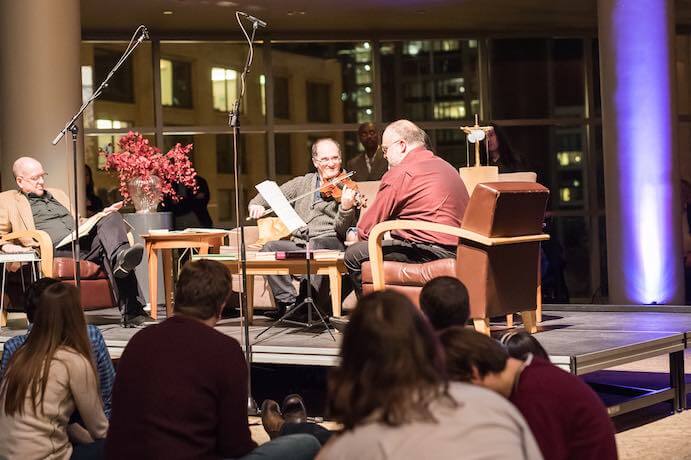In the Grand Lobby of Benaroya Hall on February 5, 2016 at 10:00pm, the Seattle Symphony Orchestra’s [untitled] 2 concert was set to begin. Dedicated to Robert Rauschenberg, a pivotal member of the New York School of visual art, the concert was set in front of his work Echo. The Seattle Symphony drew inspiration from Rauschenberg’s influence and performed works by famed composers of the New York School of composition: John Cage, Morton Feldman, Earle Brown, and Christian Wolff. A packed audience sat around the center stage with many more on the floor with blankets or standing in the back. Elena Dubinets, the Vice President of Artistic Planning, introduced the concert with a background of the New York School’s core values: to reject tradition and demand individual technique and processes from its artists. Cristina Valdes opened the concert with Morton Feldman’s Intersections No. 2, ensuring to embody these values in her performance.
Feldman once said of Intersections No. 2, “My desire is not to ‘compose’ but to project sounds into time.” Valdes certainly brought her individual technique to this solo piano work, projecting sounds with an aggressive vivacity into the space. Contrasting pulsive and sporadic rhythms, stark, sudden changes of register, articulation, and sustain, Valdes brought an invigorating interpretation to a work that often receives torpid performances. Valdes varied the note durations to add refreshing negative space, conjuring angst through various densities of sound. Such a distinct and commanding performance was the perfect way to showcase the New York School’s values of individuality and experimentation.
Earle Brown is known for his experimentations with graphic scores; the programmed work was Four Systems. Valdes and David Sabee performed this work, for open instrumentation, which contains myriad possible interpretations. With a pluck of the piano strings and a colorful cello double-stop, the work began with an intriguing aura. Vibrant timbres, beautifully placed between raw and aggressive noises and brilliantly fragile spaces, kept the audience entranced. Valdes and Sabee derived meaning from the graphic symbols in the moment, each listening to the sounds filling the space and meeting fragility with more fragility. The performance allowed for sounds to exist on their own and decay without the necessity to progress.

John Cage Living Room Music– Photo by Brandon Patoc
A raised stage lay set to the left of the audience with a sofa, a leather chair, a coffee table, books, and a lamp. John Cage’s Living Room Music began with an enthusiastic, polyrhythmic groove of books closing and pounding on the table. All the performers exuded a spirited liveliness, moving with the rhythms and fully committing to the scenery. Mikhail Shmidt’s simple, melancholic violin solo in the 3rd movement, “Melody,” made the most of every gesture and captivated the audience with emotion. As the background drumming became livelier, percussionist Rob Tucker rocked his chair forward and slammed it down to create a deep booming sound, causing laughter to spread through the crowd. The laughter continued to grow in the final movement, “Ending,” as Tucker frantically pulled the chains of the old lamp, rapidly turning the lights on and off. The choreography and commitment to the spirit of the work created an eccentric, cheerful, and humorous performance.
Continuing with his own brand of wit and humor, Christian Wolff introduced the world premiere of his new work, For Bob II. This work was inspired by two of Robert Rauschenberg’s works, Rebus and Erased de Kooning. The latter is a work in which Rauschenberg commissioned a drawing by Kooning and erased most of it. Likewise, in a nod to Feldman, Wolff states, “… the end of the work quotes [Feldman’s] For Kooning, except I erased most of it.” Wolff’s piece matched the wit he displayed in the introduction, featuring a collage of greatly contrasting sections. “I enjoy humor, surprise. Trick is to let it happen, not force it,” said Wolff.
The piece began with lush colors and timbres, almost immediately moving into sporadic rhythms, followed by fragments of American folk songs and bluegrass; each of these moments was wonderfully scored, keeping the audience wondering what would come next. The ensemble displayed incredible virtuosity jumping styles, doing so with vigor and precision. Through the collage of momentary sections, the sheer contrast amongst sections became its own interesting structural point, propelling the piece forward. Each individual moment and sound was intriguing unto itself. For Bob II displayed a nuanced and brilliantly intuitive understanding of momentum and energy, creating waves of intensity while wildly varying material, all the while retaining the humor and wit Wolff finds important.
![Seattle Symphony presents untitled [2]-- Photo by Brandon Patoc](http://icareifyoulisten.com/wp-content/uploads/2016/02/seattle-untitled2-photo-by-brandon-patoc-691px.jpg)
Seattle Symphony presents [untitled] 2– Photo by Brandon Patoc
A roar of enthusiastic applause filled the lobby, some in awe, others in excitement. The performers portrayed the unique interests of each composer of the New York School as demonstrated in their works. No piece on the concert was presented without a fully committed and engaging performance, arousing the interest of every listener. Robert Rauschenberg’s Echo magnified the brilliant performance by the Seattle Symphony of the New York School composers: a perfect, analogous artwork representing the weight and importance of the monumental works performed.


![Untitled Two [2]](https://icareifyoulisten.com/wp-content/uploads/2016/02/seattle-untitled-photo-by-brandon-patoc-691px.jpg)


















